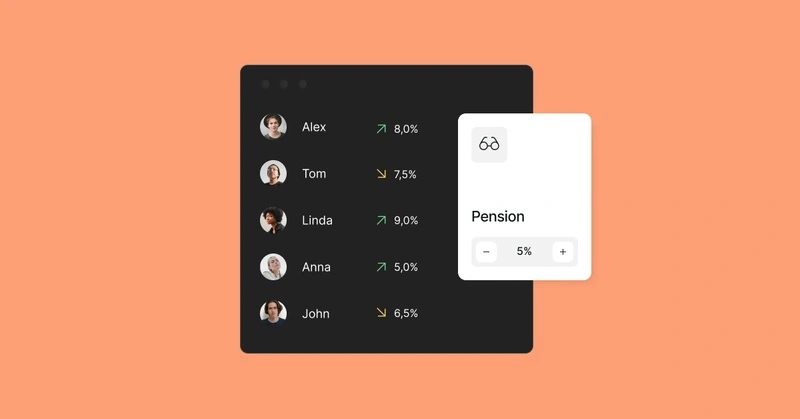Employee NI Calculator and Guide for 2025/26
As an employer, you are responsible for deducting employee NI contributions from your employees’ salaries Use our calculator to know exactly how much you need to contribute for NI. Use this NI calculator to calculate how much NI contributions you need to deduct.
Note: The web calculator above has not yet been updated for the 2025/26 tax year, please use the spreadsheet version downloadable below.
What are National Insurance contributions?
National Insurance (NI) contributions in the UK are a type of mandatory tax that employees and employers pay a part of their income to the government. These contributions funds the welfare system of the UK, such as;
- State Pension
- Jobseeker’s Allowance
- Maternity Allowance
- NHS (indirectly)
If you regularly pay NI contributions, you are eligible for a State Pension in the future. The main purpose of this system is to help people when they retire or get sick.
What are employee National Insurance contributions?
When a person works in a company, NI contributions are automatically deducted from their annual salary. This portion, which is paid by the employee, is referred to as employee NI.
How does an Employee NIC calculator work?
The employee NIC calculator is a digital tool that helps to calculate the amount of NI contributions to be paid on the basis of your salary and NI category. Usually you have to give your salary, NI category, and tax year into the calculator, and it will give you the results, which will be your estimated NI pay.
Recent National Insurance rate changes
Employee NI rates and thresholds are not effected by the recent UK government budget and will remain the same for the coming tax year 2025/26. Employer NI is affected, however. The below tables summarises the changes in the last tax years for the most common NI letter A.
| Date | What changed | Employee NI | Employer NI |
|---|---|---|---|
| Nov 2022 | Base rate Base threshold Higher rate |
13.25% → 12% £823 → £1,048 3.25% → 2% |
15.05% → 13.8% |
| Jan 2024 | Base rate | 12% → 10% | |
| Apr 2024 | Base rate | 10% → 8% | |
| Apr 2025 | Base rate | 13.8% → 15% £9,100 → £5,000 |
The National Insurance categories
There are 8 employee National Insurance categories that determine an employee’s NI contributions rates and the thresholds relevant for their NI-free allowance. This table covers the most relevant categories:
| NI Letter | Employee Group |
|---|---|
| A | Category A covers all employees except those in categories B, C, H, J, M, V and Z. Most employees fall under category A |
| B | Married and widowed women who are eligible for reduced NI contributions |
| C | Employees who are over the State Pension age |
| H | Apprentices under the age of 25 |
| J | Employees who are paying their NI contributions through another job |
| M | Employees under the age of 21 |
| V | Army Veterans in their first employment |
| Z | Employees under the age of 21 who are also paying their NI contributions through another job |
How is NI calculated?
Different to employer NI contributions, where there is only one rate and one threshold, employee NI deductions take into account two different thresholds and contribution rates, a higher one and a lower one.
This has the effect that – for most NI category letters – deductions for every additional 1£ earned above the higher threshold of £50,268 per year increases deductions only c. 1/4 as much as income below that level, benefiting high earners.
Employee NI deduction rates
Calculating employee NI deductions is following a simple formula. Employees pay 0% on income below their monthly allowance and a certain rate on income that falls between the two thresholds and above the upper threshold. Starting from 6 January 2024 the following NI contributions rates for employee deductions are effective.
| NI Letter | Allowance (up to £1,048) |
Threshold 1 (£1,048 to £4,189) |
Threshold 2 (Over £4,189) |
|---|---|---|---|
|
A, F, H, M, V
(most)
|
0% | 8% | 2% |
| B, I | 0% | 1.85% | 2% |
| J, L, Z | 0% | 2% | 2% |
Formula to calculate employee NI deductions
For employees with NI categories A, F, H, M and V that means employee NI deductions are calculated according the formula below. To adjust the formula with employee of other categories you just need to replace the rates in the formula with those shown in the table above.
+ 10% x (Income between £1,048 and £4,189)
+ 2% x (Income above £4,189)
= Employee NI deduction
Table with employee NI deductions at different annual salaries
You can find below the annual employee NI deductions for salaries from £20,000 to £80,000 per annum, and for different NI classes. In this table, we’ve taken into account the increased NI contributions rates effective 6 April 2024.
|
Annual Salary |
A, F, H, M, V (8% + 2%) |
B, I (1.85% + 2%) |
J, L, Z (2%) |
|---|---|---|---|
|
£20,000 |
£854 |
£397 |
£ |
|
£25,000 |
£1,429 |
£664 |
£ |
|
£30,000 |
£2,004 |
£932 |
£ |
|
£35,000 |
£2,579 |
£1,200 |
£ |
|
£40,000 |
£3,154 |
£1,467 |
£ |
|
£45,000 |
£3,729 |
£1,734 |
£ |
|
£50,000 |
£4,304 |
£2,002 |
£ |
|
£55,000 |
£4,429 |
£2,111 |
£ |
|
£60,000 |
£4,529 |
£2,211 |
£ |
|
£65,000 |
£4,629 |
£2,311 |
£ |
|
£70,000 |
£4,729 |
£2,411 |
£ |
|
£75,000 |
£4,829 |
£2,511 |
£ |
|
£80,000 |
£4,929 |
£2,611 |
£ |
Employee benefits and some expenses also require NI deductions
National Insurance is also payable on any employee benefits or expenses. Employers must report and pay this particular NI liability at the end of the tax year. You must pay NI on benefits such as work phones, accommodation, and bonuses. Note that every expense and benefit is calculated differently, so you need to check on what you’re required to report and pay.
You can use this benefit in kind calculator to determine how much NI you need to pay for a benefit based on its value.
You have to complete a P11D form for every employee that you have given benefits or expenses to and return it to HMRC. It is possible to deduct and pay class 1A NI through your payroll as long as you remember to register with HMRC before the beginning of the tax year.
Directors of Limited Companies
Company directors also need to pay NI contributions on any income over £9,880 as they are also considered employees . NI liability is calculated from annual earnings but is paid in accordance with your applicable payroll schedule. Even if you’re the only employee of your company and you’re the director, your company will still need to pay NI on your salary.
You also have to pay to employer NI contributions?
Besides deduction NICs from employee pay, employers also contribute NICs on top. The following table shows a summary of the contributions and thresholds and you can use this employer NI contributions calculator to understand how much NIC you need to pay.
|
NI category |
Income Threshold (from 6 August 2022) |
Employer NI on Earnings up to threshold |
Employer NI on Earnings above threshold |
|---|---|---|---|
|
A, B, C, J (most employees) |
£758 pm (£175 pw) |
0% |
13.8% |
|
H, M, V, Z (youngsters, veterans) |
£4,189 pm (£967 pw) |
0% |
13.8% |
Final Thoughts
The National Insurance hike, though costly, is straightforward, once you figure it out. However, one thing you want to avoid with the income thresholds changing in April and again in July 2022, is adjusting your payroll manually. Your payroll software should take care of these changes seamlessly and communicate those to your employees on their payslips. Finally, you can look into the different methods of reducing your NI bill which could benefit both you and your employees.
Frequently Asked Questions
Do employers pay National Insurance in the UK?
Yes, employers need to pay National Insurance in the UK. To do this, they deduct their employees’ NI contributions, which they pay on their behalf. They also need to pay an additional additional NI contribution on employees’ earnings above the relevant threshold.
How much NI does an employer pay in the UK?
The factors that define the amount of NI contributions you need to pay as an employer are the size of your business and the National Insurance category of your employees. For example, for the tax year 22/23, the NI contribution that employers need to pay is 15.05% on any employee earnings exceeding the secondary threshold (£175/week or £758/month).
Do employers pay NI for employees in the UK?
As an employer in the UK, you need to deduct your employees’ NI contributions as well as pay your own contributions for employer NI insurance on the earnings of your employees.
How is NI calculated?
NI is calculated by payroll software as a percentage on the gross income of an employee's income. Employees pay a typically 12% up to a certain threshold, and 2% above that, and get this amount deducted automatically from their pay. Additionally, employers also pay an amount, typically 13.8% on top of the employee contributions. However, there is an allowance, typically £1,048 per month, which is free from NI, so you only pay on amounts above that amount.
 To view how these values are calculated and compare tax years, you can download the Excel calculator by entering your details to receive it via email. Spot an error or have feedback? Let us know.
To view how these values are calculated and compare tax years, you can download the Excel calculator by entering your details to receive it via email. Spot an error or have feedback? Let us know.


